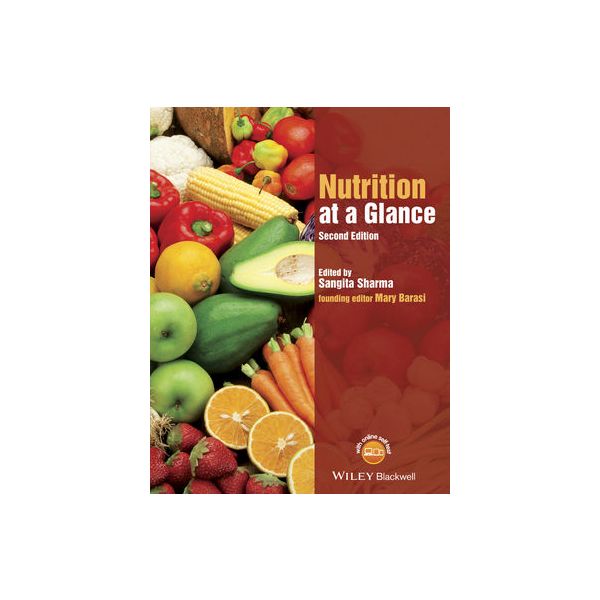Nutrition at a Glance
| Author | Sharma, Sangita |
|---|---|
| Table Of Content | Acknowledgements viii How to use your textbook ix About the companion website xi Part I Nutrients including carbohydrates, fat, proteins, vitamins, minerals, and alcohol 1 1 Introduction to the nutrients 2 2 The relationship between diet, health and disease 4 3 Energy intake: Food sources 6 4 Energy: Control of food intake 8 5 Energy: Measurement of requirements 10 6 Energy requirements: Components of energy expenditure 12 7 Carbohydrates: Simple and complex carbohydrates 14 8 Carbohydrates: Digestion and utilisation in the body 16 9 Fats: Types of fatty acids 18 10 Fats: Compound lipids (triglycerides, phospholipids, cholesterol, and phytosterols) 20 11 Fats: Digestion and utilisation in the body 22 12 Proteins: Chemistry and digestion 24 13 Proteins: Functions and utilisation in the body 26 14 Proteins: Needs, sources, protein quality and complementation 28 15 Dietary supplements 30 16 Micronutrients: Fat‑soluble vitamins 32 17 Micronutrients: Water‑soluble vitamins 34 18 Micronutrients: Major minerals 36 19 Micronutrients: Trace elements 38 20 Micronutrients: Role in metabolism 40 21 Micronutrients and circulatory system I 42 22 Micronutrients and circulatory system II 44 23 Micronutrients: Protective and defence roles I 46 24 Micronutrients: Protective and defence roles II 48 25 Micronutrients: Structural role in bone I 50 26 Micronutrients: Structural role in bone II 52 27 Alcohol 54 28 Fetal alcohol spectrum disorder 56 29 Fluids in the diet 58 Part II Nutritional epidemiology including assessments, consequences and food choices 61 30 Introduction to nutrition epidemiology: Study designs I 62 31 Introduction to nutrition epidemiology: Study designs II 64 32 Research ethics 66 33 Nutritional assessment methods: Anthropometric assessment 68 34 Nutritional assessment methods: Dietary assessment I 70 35 Nutritional assessment methods: Dietary assessment II 72 36 Inadequate nutritional intakes: Causes 74 37 Inadequate nutritional intakes: Consequences 76 38 Definitions of an adequate diet 78 39 Creating an adequate diet 80 40 Optimising nutrition 82 41 Excessive or unbalanced nutritional intakes 84 42 Food choice: Individual, social and cultural factors 86 43 Food choice: The food environment 88 44 Nutrition in ethnic minority groups and potential impact of religion on diet 90 Part III Nutrition throughout the life cycle 93 45 Nutrition in pregnancy and lactation 94 46 Nutrition in infants, toddlers and preschool children 96 47 Nutrition in school‑age children and adolescents 98 48 Nutritional challenges in infants, children and adolescents 100 49 Nutrition and early origins of adult disease 102 50 Nutrition in older adults 104 Part IV The role of nutrition in key organs/systems 107 51 Nutrition and the gastrointestinal tract I 108 52 Nutrition and the gastrointestinal tract II 110 53 Nutrition and the brain I 112 54 Nutrition and the brain II 114 55 Nutrition and the eye 116 Part V Nutrition‑related diseases 119 56 Overweight and obesity: Aetiological factors 120 57 Overweight and obesity: Consequences for health and chronic disease 122 58 Overweight and obesity: Insulin resistance and metabolic syndrome 124 59 Overweight and obesity: Prevention and management 126 60 Overweight and obesity: Popular slimming diets 128 61 Underweight and negative energy balance 130 62 Nutrition and cancer I 132 63 Nutrition and cancer II 134 64 Diet and cardiovascular disease: Aetiology 136 65 Diet and cardiovascular disease: Prevention 138 66 Adverse reactions to food and inborn errors of metabolism 140 Part VI Public health and sports nutrition 143 67 Nutritional genomics 144 68 Nutrition transition 146 69 Promoting nutritional health: A public health perspective I 148 70 Promoting nutritional health: A public health perspective II 150 71 Promoting nutritional health: The role of the dietitian 152 72 Nutrition and sport I 154 73 Nutrition and sport II 156 Part VII Foods, phytochemicals including functional and genetically modified foods 159 74 Functional foods 160 75 Phytochemicals 162 76 Genetically modified foods 164 77 Food safety 166 Appendices 168 Appendix A1 Structures of the fat‑soluble vitamins A, D, E and K 168 Appendix A2 Structures of the water‑soluble vitamins: Thiamin, riboflavin, niacin, vitamin B 6 , biotin, pantothenic acid, folic acid, vitamin B 12 and vitamin C 170 Appendix A3 Structures of the major classes of phytochemicals 172 Bibliography 174 Index 177 |
| Publish Date | 6 Nov 2015 |





